Tourism in Bangladesh
Tourism in Bangladesh is a developing foreign currency earner. The country was listed by Lonely Planet in 2011 as the "best value destination".
Bangladesh's tourist attractions include, historical and monuments, resorts, beaches, picnic spots, forests and tribal people, wildlife of various species. Bangladesh offers ample opportunities to tourists for angling, water skiing, river cruising, hiking, rowing, yachting, sea bathing as well as bringing one in close touch with pristine nature.
In the northern part, comprising the Rajshahi division, there are archaeological sites, including the temple city Puthia in Rajshahi; the largest and most ancient archaeological site, Mahasthangarh in Bogra; the single largest Buddhist monastery, Paharpur in Naogaon; the most ornamental terracota Hindu temple in Bangladesh Kantaji Temple, and many rajbaris or palaces of old zamindars.
In the south-eastern part, which is the Chittagong division, there are natural and hilly areas like Chittagong Hill Tracts, along with sandy sea beaches. The most notable beach, in Cox's Bazar, is a contender for the title of longest unbroken sandy sea beach in the world.
Cox's Bazar is the longest natural unbroken sea beach in the world.
In the south-western part, mainly the Khulna Division, there is the Sundarbans, the largest mangrove forest of the world with Royal Bengal Tiger and spotted deer. The historically and architecturally important sixty domed mosque in Bagerhat is a notable site. In the north-eastern part, Sylhet division, there is a green carpet of tea plants on small hillocks. Natural reserved forests are great attractions. Migratory birds in winter, particularly in the haor areas, are also very attractive in this area.
Ministry of Tourism and The Civil Aviation Ministry designs national policies for the development and promotion of tourism. The Ministry also maintains the Beautiful Bangladesh campaign.
Economic impact
The World Travel and Tourism Council (WTTC) reported in 2013 that the travel and tourism industry in Bangladesh directly generated 1,281,500 jobs in 2012 or 1.8 percent of the country's total employment, which ranked Bangladesh 157 out of 178 countries worldwide. Direct and indirect employment in the industry totalled 2,714,500 jobs, or 3.7 percent of the country's total employment. The WTTC predicted that by 2023, travel and tourism will directly generate 1,785,000 jobs and support an overall total of 3,891,000 jobs, or 4.2 percent of the country's total employment. This would represent an annual growth rate in direct jobs of 2.9 percent. Domestic spending generated 97.7 percent of direct travel and tourism gross domestic product (GDP) in 2012. Bangladesh's world ranking in 2012 for travel and tourism's direct contribution to GDP, as a percentage of GDP, was 142 out of 176.Chittagong division
Cox's Bazar
Main article: Cox's Bazar
 |
| Cox's Bazar is the longest natural unbroken sea beach in the world. |
Cox's Bazar (Bengali: কক্সবাজার Kaksbajar) is a seaside town, a fishing port and district headquarters in Bangladesh. It is known for its wide and long sandy beach, which is considered by many as the world's longest natural sandy sea beach. The beach in Cox's Bazar is an unbroken 125 kilometres (78 mi) sandy sea beach with a gentle slope. It is located 152 kilometres (94 mi) south of the industrial port of Chittagong. Cox's Bazar is also known by the name Panowa, whose literal translation means "yellow flower". Its other old name was "Palongkee".
St. Martin's Island
Main article: St. Martin's Island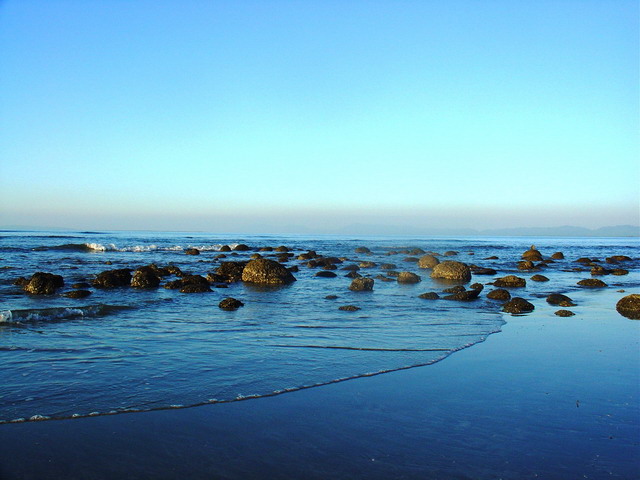 |
| Dead corals at St. Martin's Island |
St. Martin's Island (Bengali: সেন্ট মার্টিন্স দ্বীপ) is a small island (area only 8 km2) in the northeastern part of the Bay of Bengal, about 9 km south of the tip of the Cox's Bazar-Teknaf peninsula, and forming the southernmost part of Bangladesh. There is a small adjoining island that is separated at high tide, called Chhera island. It is about 8 km west of the northwest coast of Myanmar, at the mouth of the Naf River. The first settlement started just 250 years ago by some Arabian sailors who named the island ‘Zajira’. During British occupation the island was named St. Martin Island. The local names of the island are "Narical Gingira", also spelled "Narikel Jinjira/Jinjera", which means 'Coconut Island' in Bengali, and "Daruchini Dip". It is the only coral island in Bangladesh.
The city of Chittagong has many high end, private hotels such as the Hotel Agrabad, the Hotel Well Park Residence, The Peninsula Chittagong, the Hotel Harbour View, the Hotel Meridian, and Avenue Hotels and Suites.
The JW Marriott, Westin and Radisson Blu are among the upcoming five-star hotels in Chittagong city.
Bandarban District
Main article: Bandarban District |
| Nilgiri, Bandarban |
Bandarban (Bengali: বান্দরবান) is a district in South-Eastern Bangladesh, and a part of the Chittagong Division and Chittagong Hill Tracts. Bandarban is regarded as one of the most attractive travel destinations in Bangladesh. Bandarban (meaning the dam of monkeys), or in Marma or Arakanese language as "Rwa-daw Mro" is also known as Arvumi or the Bohmong Circle (of the rest of the three hill districts Rangamati is the Chakma Circle, Raja Devasish Roy and Khagrachari is the Mong Circle, Raja Sachingprue Marma). Bandarban town is the home town of the Bohmong Chief (currently King, or Raja, U Cho Prue Marma) who is the head of the Marma population. It also is the administrative headquarters of Bandarban district, which has turned into one of the most exotic tourist attractions in Bangladesh.
Rangamati
Main article: Rangamati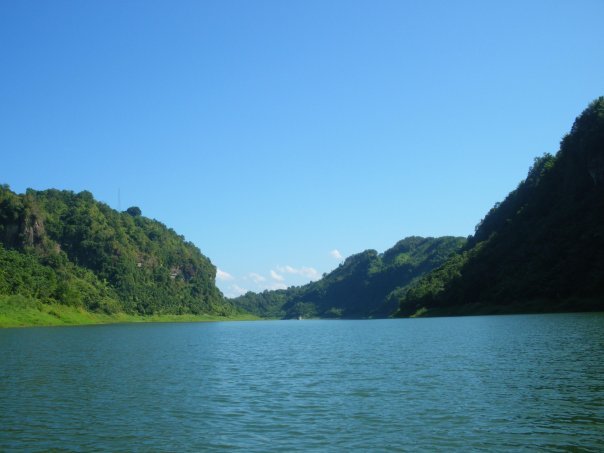 |
| Kaptai Lake, Rangamati |
Rangamati (Bengali: রাঙ্গামাটি) is the administrative headquarters of Rangamati Hill District in the Chittagong Hill Tracts of Bangladesh. The town is located at 22°37'60N 92°12'0E and has an altitude of 14 metres (49 feet).It's a travel destination of Bangladesh which is known as "Lake City". Kaptai lake, the hanging bridge and Pablakhali reserve forest are some of the notable locations to visit in Rangamati.
Khagrachari District
Main article: Khagrachari District |
| Shubhalang waterfall, Rangamati |
Khagrachari (Bengali: খাগড়াছড়ি[needs IPA]) is a district in south-eastern Bangladesh. It is a part of the Chittagong Division and the Chittagong Hill Tracts. Its local name is "Chengmi". Khagrachari is also known as Phalang Htaung (ဖလံေထာင္) or the Mong Circle (of the rest of the three hill districts Rangamati is the Chakma Circle (သက္ေထာင္) and Bandarban (ဗိုလ္မင္းေထာင္) is the Bohmong Circle). It's a travel destination of Bangladesh which is known as "Lake City".The district is administered by an office named as District Administration,Rangamati
Patenga beach
Main article: PatengaA tourist attraction near Patenga beach is the Butterfly Park.
Foy's Lake
Main article: Foy's Lake |
Foy's Lake
|
Foy's Lake is a human-made lake in Chittagong, Bangladesh. The lake was once just a lake and spillway constructed by Assam-Bengal Railway engineer. It was dug in 1924 and was named after the English engineer Mr. Foy. The lake is next to Batali Hill, the highest hill in Chittagong Metropolitan area. An amusement park, managed by the Concord Group, is located here.
Heritage Park
There is a heritage park called Shaheed Zia Memorial Complex and Mini Bangladesh at Chandgaon which reflects the most notable structures and instances of Bangladesh. This 71-metre tower in Mini Bangladesh in Chittagong has a restaurant on the top that rotates once every 90 minutes. The museum includes a revolving restaurant. One can perceive of the country's architectural beauty, ethnic traditions and archaeological inheritance through having a glimpse of the heritage park. Replica of major structures of the country, includes Jatiya Sangsad Bhaban (parliament building), National Memorial of Savar, Ahsan Manzil, Curzon Hall of Dhaka University, Paharpur Monastery, Kantajew Temple of Dinajpur, Lalbagh Fort and Sona Masjid. The park also has different rides for children.Ethnological Museum of Chittagong
Main article: Ethnological Museum of Chittagong |
| Chittagong Ethnological Museum |
The Ethnological Museum of Chittagong located in Agrabad, established in 1965, is the only ethnological museum in the country. It offers the visitors the chance to acquaint with the lifestyles and heritage of various ethnic groups of the country. The museum authority had collected rare elements used in everyday lives of different ethnic groups, of which some had already become extinct while some were on the verge of extinction. The museum contains four galleries and a small hall. Three galleries of the museum feature diverse elements of twenty nine ethnic groups in Bangladesh, while the rest of the gallery displays the lifestyles of some ethnic groups of India, Pakistan and Australia.
WWII cemetery and Circuit House
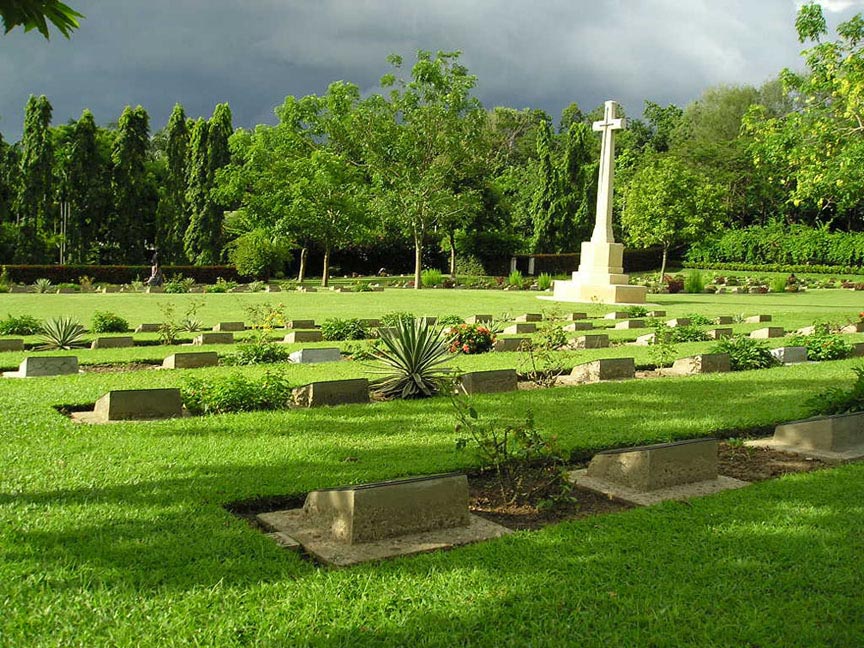 |
| Chittagong War Cemetery |
Dhaka division
Lalbagh Fort
Main article: Lalbagh Fort |
| Lalbagh Fort, Dhaka, Bangladesh |
Lalbagh Fort is an incomplete 17th century Mughal fort complex in Dhaka, Bangladesh. This fort (also known as Fort Aurangabad)stands proudly before the Buriganga River in the southwestern part of Dhaka, Bangladesh. The construction was started in 1678 AD by Mughal Subahdar Muhammad Azam Shah. For long the fort was considered to be a combination of three buildings (the mosque, the tomb of Bibi Pari and the Diwan-i-Aam), with two gateways and a portion of the partly damaged fortification wall. Recent excavations carried out by the Department of Archaeology of Bangladesh have revealed the existence of other structures.
Ahsan Manzil
Main article: Ahsan Manzil |
| Ahsan Manzil |
Ahsan Manzil (Bengali: আহসান মনিজল, Ahsan Manzil) is a wonderful ancient building, located on the bank of the river Buriganga, in old Dhaka at Kumartoli, Islampur area. It was a residential palace for Dhaka Nawab Family. The structure of this palace was started in the year 1859 and was finished in 1869. It is constructed in the Indo-Saracenic Revival architecture. To preserve the cultural and history of the area, the palace became the Bangladesh National Museum on 20 September 1992.
Shaheed Minar
On 21 February 1952, dozens of students and political activists were killed when the Pakistani police force opened fire on Bengali protesters who were demanding equal status for their native tongue, Bengali. The massacre occurred near Dhaka Medical College and Ramna Park in Dhaka. A makeshift monument was erected on 23 February by students of University of Dhaka and other educational institutions, but demolished on 26 February by the Pakistani police force.
The Language Movement gained momentum, and after a long struggle, Bengali was given equal status with Urdu. To commemorate the dead, the Shaheed Minar was designed and built by Hamidur Rahman, a Bangladeshi sculptor. The monument stood until the Bangladesh Liberation War in 1971, when it was demolished completely during Operation Searchlight. After Bangladesh gained independence, it was rebuilt.
At present, all national, mourning, cultural and other activities held each year, regarding 21 February, have been centered around the Shaheed Minar.
Jatiyo Smriti Soudho
Jatiya Sangshad
(National Parliament – Bengali: জাতীয় সংসদ ভবন): Jatiyo Sangsad Bhaban was created by American architect Louis I. Kahn. Construction was started in 1961 and completed on 28 January 1982 with the total cost was about 32 million dollars. It is situated at Shre-e-Bangla Nagar in Dhaka. Jatiyo Sangsad Bhaban was used for the first time on 15 February 1982 as the venue for the eighth (last) session of the second parliament of Bangladesh. Since then, it has been used for the Bangladesh National Assembly.Rajshahi and Rangpur Division
Somapura Mahavihara
Main article: Somapura MahaviharaSomapura Mahavihara (Bengali: সোমপুর মহাবিহার Shompur Môhabihar) in Paharpur, Badalgachhi Upazila, Naogaon District, Bangladesh (25°1'51.83"N, 88°58'37.15"E) is among the best known Buddhist viharas in the Indian Subcontinent and is one of the most important archeological sites in the country. It was designated a UNESCO World Heritage Site in 1985.
Mahastangar
Main article: Mahasthangarh |
| Somapura Mahavihara is a World Heritage Site. |
Mahasthangarh (Bengali: মহাস্থানগড় Môhasthangôṛ) is one of the earliest urban archaeological sites so far discovered in Bangladesh. The village Mahasthan in Shibganj thana of Bogra District contains the remains of an ancient city which was called Pundranagara or Paundravardhanapura in the territory of Pundravardhana. A limestone slab bearing six lines in Prakrit in Brahmi script, discovered in 1931, dates Mahasthangarh to at least the 3rd century BC. The fortified area was in use till the 18th century AD.
Behula Lakshindar Basor Ghor
Main article: Behula |
| Behula Lakhindar Basor Ghor at Bogra |
Behula (Bengali: বেহুলা) is the protagonist in the Manasamangal genre of Bengali medieval epics. A number of works belonging to this genre were written between the thirteenth and eighteenth centuries. Though the religious purpose of these works is to eulogise the Hindu goddess Manasa, these works are more well known for depicting the love story of Behula and her husband Lakhindar.
Kantajew Temple
Main article: Kantajew TempleKantaji Temple (Bengali: কান্তজীউ মন্দির) at Kantanagar, is a late-medieval Hindu temple in Dinajpur, Bangladesh. Built by Maharaja Pran Nath, its construction started in 1704 CE and ended in the reign of his son Raja Ramnath 1722 CE, during the reign of his son Maharaja Ramnath. It boasts one of the greatest examples on Terracotta architecture in Bangladesh and once had nine spires, but all were destroyed in an earthquake that took place in 1897.
Varendra Research Museum
Varendra Museum is a museum, research center and popular visitor attraction located at the heart of Rajshahi town and maintained by Rajshahi University in Bangladesh.
Bagha Mosque
 |
| Varendra Research Museum |
Barisal division
Kuakata Beach
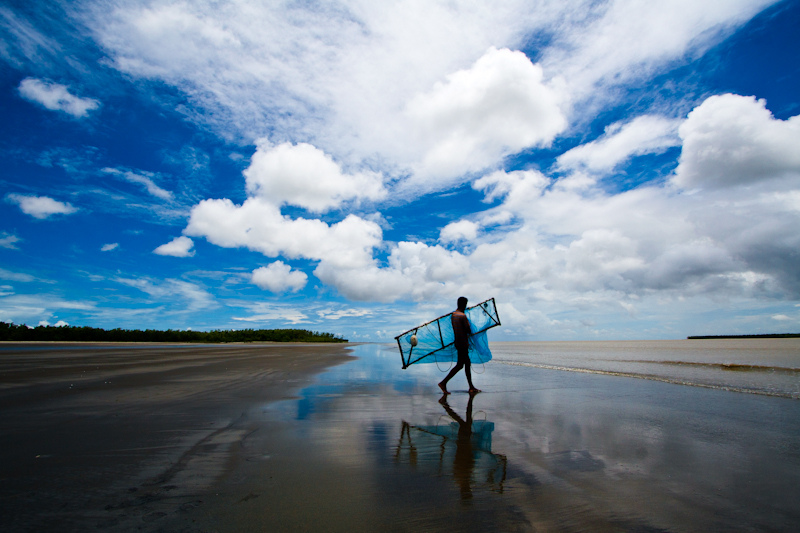 |
| Kuakata beach |
Kuakata is a panaromic sea beach on the southernmost tip of Bangladesh. Located in the Patuakhali district, Kuakata has a wide sandy beach from where one can see both the sunrise and sunset.It is about 320 Kilometers south of Dhaka, the capital, and about 70 Kilometers from the district headquarters. The Kuakata beach is 30 km long and 6 km wide. On the eastern end of the beach is Gongamati Reserved Forest, an evergreen mangrove forest and snippet of the original Kuakata. When the Rakhines settled in the area in 1784, Kuakata was part of the larger Sundarbans forest. However, the Sundarbans is now at a distance of one-hour by speed boat. As a mangrove forest, Gongamati, like the Sundarbans, offers some protection against tidal surges, however it too is being threatened by logging and deforestation. The best way to reach the forest is by foot or bike along the beach, where a flock of flag flying fishing boats can be seen trawling the coast. Choosing to visit Gangamati in the late afternoon is a perfect time to watch the sun caste shadows on the abstract exposed mangrove roots.
Sylhet divisionLawachara National Park
Main article: Lawachara National ParkLawachara National Park (Bengali: লাউয়াছড়া) is a major national park and nature reserve in Bangladesh. The park is located at Kamalganj Upazila, Maulvi Bazar District in the northeastern region of the country. It is located within the 2,740 ha (27.4 km2) West Bhanugach Reserved Forest.
Madhabkunda waterfall
Main article: Madhabkunda waterfallMadhabkunda waterfall (Bengali: মাধবকুন্ড) is one of the largest waterfalls in Bangladesh. It is situated in Barlekha thana (subdistrict) in Moulvi Bazar District, Sylhet Division. The waterfall is a popular tourist spot in Bangladesh. Big boulders, surrounding forest, and the adjoining streams attracts many tourists for picnic parties and day trips.
Jaflong
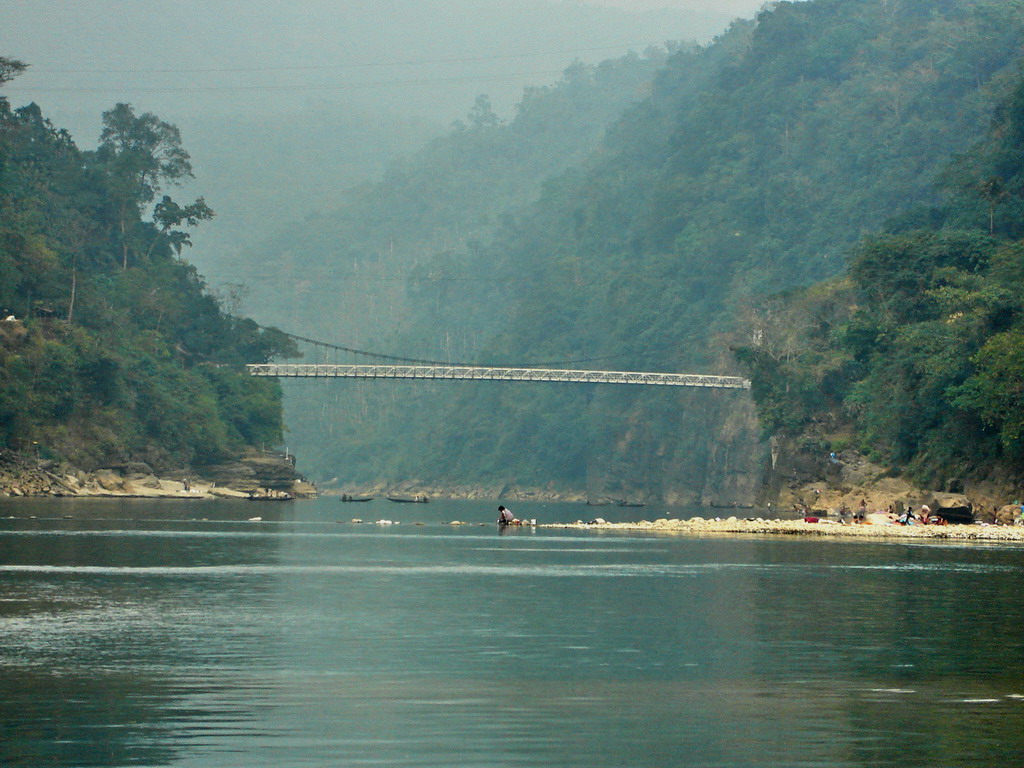 |
| Zero Point at Zuflong |
Jaflong is a natural tourist spot in the Division of Sylhet, Bangladesh. It is located in Gowainghat Upazila of Sylhet District and situated at the border between Bangladesh and the Indian state of Meghalaya. It is just below the mountain range. Jaflong is famous for its stone collections and is home of the Khasi tribe.
Khulna Division
Sundarbans
Main article: SundarbansThe Sundarbans (Bengali: সুন্দরবন, Shundorbôn) is the largest single block of tidal halophytic mangrove forest in the world. The Sunderbans is a UNESCO World Heritage Site, most of which is situated in Bangladesh with the remainder in India. Sundarbans South, East and West are three protected forests in Bangladesh. This region is densely covered by mangrove forests, and is one of the largest reserves for the Bengal tiger.
Mosque City of Bagerhat
Main article: Mosque City of BagerhatThe Mosque City of Bagerhat (Bengali: মসজিদের শহর বাগেরহাট) is a formerly lost city, located in the suburbs of Bagerhat city in Bagerhat District, in the Khulna Division of southwest of Bangladesh. Bagerhat is about 15 miles south east of Khulna and 200 miles southwest of Dhaka.
Originally known as Khalifatabad and nicknamed the "mint town of the Bengal Sultanate", the city was founded in the 15th century by the warrior saint Turkish general Ulugh Khan Jahan.
The historic city, listed by Forbes as one of the 15 lost cities of the world, has more than 50 Islamic monuments which have been found after removing the vegetation that had obscured them from view for many centuries. The site has been recognized as a UNESCO World Heritage Site in 1983 under criteria (iv), "as an outstanding example of an architectural ensemble which illustrates a significant stage in human history", of which the Sixty Pillar Mosque (Shat Gombuj Masjid in Bengali), constructed with 60 pillars and 77 domes, is the most well known. Apart from these monuments, UNESCO also includes the mausoleum of Khan Jahan, the mosques of Singar, Bibi Begni, Reza Khoda, Zindavir among the unique monuments.
Architecture
Religious
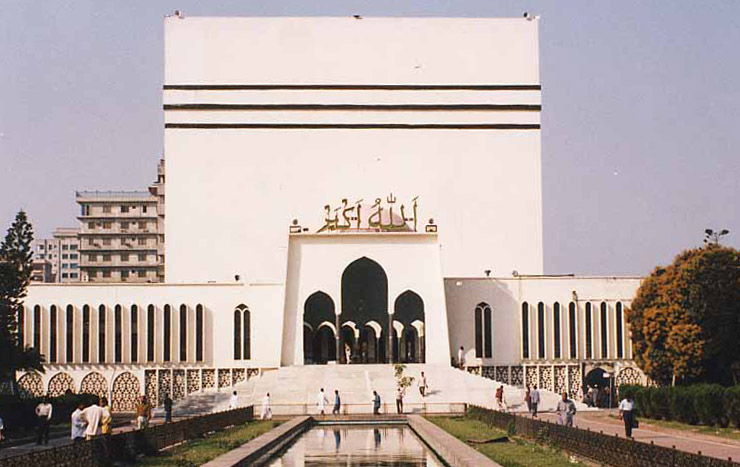 |
| The structure of Baitul Mukarram resembles the Kaaba in Mecca |
Bangladesh has many places of worship. Capital Dhaka is known as the city of mosques.
Some famous Religious Place of Worships and visitor attractions are:
Baitul Mukarram is the national mosque of Bangladesh. Located at the center of Dhaka, the mosque was completed in 1968. The mosque has a capacity of 30,000, and it is world's tenth largest mosque.
Shat Gombuj Mosque (Sixty Dome Mosque) in Bagerhat Mosque City
Mosque City of Bagerhat is a formerly lost city, located in the suburbs of Bagerhat city in Bagerhat District, in the Khulna Division. The historic city, listed by Forbes as one of the 15 lost cities of the world, has more than 50 Islamic monuments.
Kantaji Temple, A late-medieval Hindu temple in Dinajpur, Bangladesh. Built by Maharaja Pran Nath
Kantojiu Temple built between 1702 and 1752, a nava-ratna (nine-spired) style hindu temple.
Dhakeshwari Temple built in the twelfth century, a hindu temple.
Hoseni Dalan a Shia shrine built in the seventeenth century.
Sixty Dome Mosque is a mosque in Bangladesh, the largest in that country from the Sultanate period. It has been described as "the most impressive Muslim monuments in the whole of the Indian subcontinent."
Ancient ruins
.jpg/1200px-Shat_Gambuj_Mosque_(11).jpg) |
| Shat Gombuj Mosque (Sixty Dome Mosque) in Bagerhat Mosque City |
Somapura Mahavihara is a Buddhist monastery situated in the Rajshahi District in the north of Bangladesh. Covering almost 27 acres of land, Somapura Mahavira is one of the largest monasteries south of the Himalayas. The design is considered to be greatly influenced by Buddhist architecture found in Java and Cambodia.
Mainamati is an isolated ridge of low hills in the eastern margins of deltaic Bangladesh, about 8 kilometres (5.0 mi) to the west of Comilla town. A landmark of ancient history, it represents a small mass of quasi-lateritic old alluvium. The ridge, set in the vast expanse of the fertile lower Meghna basin, extends for about 17 kilometres (11 mi) north-south from Mainamati village on the Gumti River to Chandi Mura near the Lalmai railway station.
The oldest archaeological site in Bangladesh is outside Bogra, at Mahasthangarh.
Middle Age
.JPG/1200px-Kantaji_Temple_Dinajpur_Bangladesh_(12).JPG) |
| Kantaji Temple, A late-medieval Hindu temple in Dinajpur, Bangladesh. Built by Maharaja Pran Nath |
Lalbagh Fort Lalbagh Fort or Fort Aurangabad, an incomplete Mughal palace fortress at Dhaka on the river Buriganga in the southwestern part of the old city. The fort was considered to be a combination of three buildings (the mosque, the tomb of Bibi Pari and the Diwan-i-Aam), two gateways and a portion of the partly damaged fortification wall.
Ahsan Manzil was previously the official palace of the Dhaka Nawab family and is currently a museum preserving the culture and history of the area.Ahsan Manzil is considered to be one of the most noteworthy architectural monuments in Bangladesh.
Bara Katra an architectural relic of Dhaka city. It is situated to the south of Chawk Bazar close to the river buriganga.The Katra enclosed a quadrangular courtyard with 22 rooms on all of its four sides.
British architecture
 |
| Mahasthangarh at Bogra |
Northbrook Hall a hundred and fifty years old Biritsh style town hall.
Modern
Bangladesh National Museum Located in the suburb of Shahbag, in the city of Dhaka, is the biggest museum in Bangladesh. It has a collection of over eighty five thousand pieces. The four-storey building is home not only to large exhibition halls, but to a conservatory laboratory, library, three auditoriums, photographic gallery, temporary exhibition hall, and an audio-visual division..jpg/975px-Panorama_of_National_Assembly_of_Bangladesh_(02).jpg) |
| Panoramic view of Jatiyo Sangsad Bhaban. |
Jatiyo Sangshad Bhaban Parliamentary Building of Bangladesh, located in Dhaka. It was created by architect Louis Kahn and is one of the largest legislative complexes in the world. It houses all parliamentary activities of Bangladesh.
Taj Mahal Bangladesh is a Bangladeshi artictecture inspired from original Taj Mahal
Historic monuments
 |
| Ahsan Manzil Built by Khwaja Abdul Ghani in 1872 and named after his son Khwaja Ahsanullah, the Nawab of Dhaka. |
National Martyrs' Memorial is the national monument for the Bangladesh Liberation War of 1971
Martyred Intellectuals Memorial is a memorial built in memory of the martyred intellectuals of the Bangladesh Liberation War.
Suhrawardy Udyan formerly known as Ramna Race Course ground is a national memorial located in Dhaka. It is named after Huseyn Shaheed Suhrawardy.
Mosque City of Bagerhat is a formerly lost city, located in the suburbs of Bagerhat city in Bagerhat District, in the Khulna Division of southwest of Bangladesh and UNESCO World Heritage Site.
Ahsan Manzil was the official residential palace and seat of the Dhaka Nawab Family. This building is situated at Kumartoli along the banks of the Buriganga River in Dhaka.
Zia Memorial Museum is housed in an interesting mock-Tudor mansion. Among its collection is the microphone and transmitter with which President Shaheed Ziaur Rahman proclaimed the country’s independence in 1971, and you can see the blood-stained and bullet-damaged wall at the foot of the stairs where Zia was shot.
Lalbagh Fort is an incomplete seventeenth century Mughal fort complex in Dhaka. The construction was started in 1678 AD by Mughal Subahdar Muhammad Azam Shah.
Shiva Temple in Puthia consists of a cluster of notable old Hindu temples in Puthia Upazila, Rajshahi Division, Bangladesh.
Nature tourism
Bangladesh has geographical diversity, which resulted in varieties of nature tourism.The Sundarbans is the largest single block of tidal halophytic mangrove forest in the world and has also been enlisted among the top 14 finalists in the New7Wonders of Nature.
Wildlife in Bangladesh
Bangladesh is home to several well-known mammals including the Bengal Tiger, the Asian Elephant, the Hoolock gibbon and the Asian Black bear. Saltwater crocodile found in Sunderban is the is the largest of all living reptiles, The King cobra (Ophiophagus hannah) is the world's longest venomous snake and Python reticulatus is the longest among all snakes. The country has roughly 53 species of amphibian, 19 species of marine reptiles, 139 species of reptiles, 380 species of birds, 116 species of mammals, and 5 species of marine mammals. In addition to the large bird count, a further 310 species of migratory birds swell bird numbers each year. The vast majority of these creatures currently dwell in an area of land that is approximately 150,000 square kilometres (58,000 sq mi) in size. The dhole, also called the Asiatic wild dog, is now endangered by habitat, prey-species loss, and human persecution. Notable animal species that have disappeared from Bangladesh are the one- and two-horned Rhinoceros, the Gaur, the Banteng, Swamp deer, Nilgai, Indian Wolf, wild Water Buffalo, marsh crocodile and common Peafowl.
The world's largest mangrove forest Sundarbans is located in Southwestern Bangladesh. Sundarbans National Parks are UNESCO World Heritage Site.
Hill stations
 |
| Chittagong Hill Tracks is one of many famous tourist attraction in Bangladesh. |
Bandarban, Chittagong
Khagrachori, Chittagong
Rangamati Hill District
Jaflong, Sylhet
Sripur, Sylhet
Srimangal county, Sylhet
Lakes
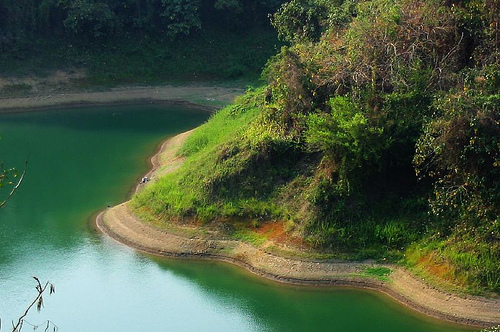 |
| View of Kaptai Lake, Rangamati |
Kaptai Lake
Dhanmondi Lake
Foy's Lake
Madhobpur Lake
Beaches
Bangladesh offers a wide range of tropical beaches. Cox's Bazar is known for its wide and long sandy beach which is considered as the world's longest natural sandy sea beach. Some of the other famous tourist beaches are:
 |
| Patenga Sea Beach in Chittagong |
St. Martin Island
Patenga sea beach
Kuakata sea beach
Nijhum Dwip
Islands
Main article: List of islands of BangladeshThe islands of Bangladesh are scattered along the Bay of Bengal and the river mouth of the Padma. There are more than 30 islands in Bangladesh. Some famous tourist attractions are:
 |
| St. Martin's Island |
St. Martin's Island, St. Martin
Chhera Island,St. Martin
Bhola Island, Bhola
Manpura Island
Nijhum Dwip, Noakhali
Sandwip Island, Chittagong
Sonadia Island, Chittagong
Tourism Campaign Films
In January 2011, two short films titled 'Beautiful Bangladesh: School of Life' were produced by Bangladesh Tourism Board (partner of ICC World Cup Cricket 2011). Both films show a tourist's journey through Bangladesh. The durations of the films were 10 and 3 minutes. The 10 minutes long film was directed by Moinul Hossain Mukul and the 3 minute long film was directed by Gazi Ahmed Shubhro. Concept and script by Syed Gousul Alam Shaon.
Shopping
 |
| Jamuna Future Park is the 12th largest shopping mall of the world. |
While muslin of ancient Dhaka has gone into history, other products such as contemporary paintings, wood works, shital pati (mats that feel cool), bamboo decoration pieces, cane and conch shell products, gold and silver ornament, cotton, silk, gold, silver, jute, reed, brass ware, traditional dolls and leather goods also receive deep appreciation of the lovers of arts and crafts now and over the past centuries. In addition, Bangladesh is famous for pink pearl.
Jamuna Future Park is the 12th largest shopping mall in the world. Bashudhara City inaugurated in 2004 is one of the largest shopping malls in sub-continent.
For more detail visit here: http://adf.ly/sN7V8


.jpg/1200px-Shiva_Temple%2C_Puthia%2C_Rajshahi_NK_(1).jpg)






0 comments:
Post a Comment